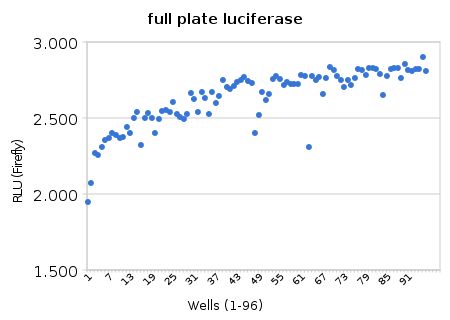How to get the most from your luciferase assay
How to get the most from your luciferase assay
Bring the lysate and the luciferin at room temperature before reading!

As low temperatures minimize protein degradation in a cell lysate, working in ice is a classic attitude in molecular biology. This is a good reflex, but sometimes inappropriate. If you directly transfer in a luminometer a 96well plate previously kept on ice, the first wells will be read at ~4°C. But wait, for each well the luminometer takes ~20 seconds (10'' for firefly and 10'' for renilla). Thus, a full plate will take 20s * 96 = 1920 sec = ~30 minutes. The last wells will be likely at room temperature. The temperature bias could sensitively affect your readings!
Want to check? Work on ice, and prepare a big lysate from cells transfected with luciferase and put 20 uL in each well of the 96well plate (alternatively you can use recombinant luciferase diluted in a phosphate buffer containing 1mg/mL BSA). Directly transfer the plate from ice to luminometer and start reading. You will observe something similar to the figure:

Firefly luciferase is an enzyme from an insect. Insects are poor thermo-regulators. Therefore most of their enzymes optimally works at room temperature. This is the case for luciferase. During your reading, the increase in the temperature sustains firefly's activity. As you can see, this phenomena efficiently balances some luciferase degradation. People is usually scared by protein degradation, but in this case it is worst to keep your plate in ice. For your comfort, you can quickly bring a plate at RT just by incubating at 37 °C for 3-4 minutes immediately before reading. Pimp your results!
See also my post on luciferase downsides.
See also my post on luciferase downsides.
